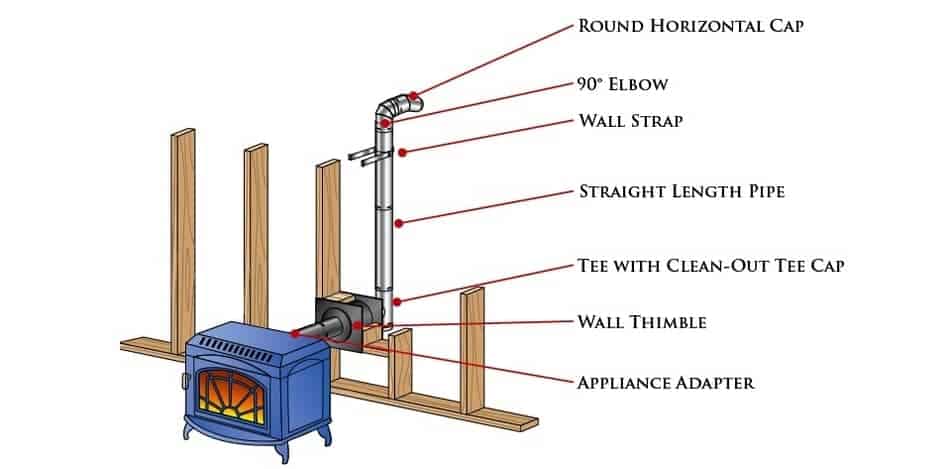Pellet stove exhaust pipe requirements include using the correct pipe size (3″ or 4″) and heat-resistant materials like stainless steel. Proper clearance and secure termination are essential for safety and efficiency.
Installing a pellet stove requires careful attention to exhaust pipe specifications to ensure safety, efficiency, and compliance with local building codes. The exhaust system plays a crucial role in venting combustion gases safely outside the home. This guide provides detailed information on the essential requirements for pellet stove exhaust pipes, including sizing, materials, installation guidelines, and maintenance practices.
Contents
Pellet Stove Exhaust Systems
Pellet stoves utilize a forced-air exhaust system to expel combustion gases. Unlike traditional wood stoves that rely on natural draft, pellet stoves require a sealed venting system to handle the pressurized exhaust. This necessitates specific materials and installation practices to ensure safe operation.
Key Requirements for Pellet Stove Exhaust Pipes
Ensuring that your pellet stove exhaust pipe meets the proper requirements is crucial for safe and efficient operation. The right size, material, and installation practices are all important factors that contribute to the stove’s overall performance and safety.
1. Vent Pipe Size
Most pellet stoves require a 3″ or 4″ diameter vent pipe. The size depends on the stove’s specifications and the manufacturer’s guidelines. It’s essential to adhere to these recommendations to maintain proper airflow and prevent overheating. Reducing the pipe size can lead to increased resistance, potentially causing backdrafts or inefficient combustion.
2. Vent Pipe Material
Pellet stove exhaust pipes should be made of durable, heat-resistant materials. Commonly used materials include:
- Stainless Steel: Offers resistance to corrosion and high temperatures.
- Galvanized Steel: Provides durability but may be less resistant to corrosion over time.
It’s crucial to use materials specifically designed for pellet stove venting to ensure safety and compliance with building codes.
3. Vent Pipe Configuration
Pellet stove venting can be configured in various ways:
- Horizontal Venting: The exhaust pipe exits through an exterior wall.
- Vertical Venting: The exhaust pipe extends through the roof.
Each configuration has specific clearance and termination requirements to prevent hazards and ensure efficient operation.
4. Clearance Distances
Maintaining proper clearance between the vent pipe and combustible materials is vital. Minimum clearance distances typically include:
- 1 inch from combustible walls or ceilings.
- 3 feet from windows, doors, or air intakes.
- 12 inches above grade level or any surface that may support snow, ice, or debris.
Always consult the stove’s manual and local building codes for specific clearance requirements.
5. Vent Termination
The termination point of the vent pipe must be positioned to prevent the re-entry of exhaust gases into the living space. Termination caps should be designed to prevent rain, snow, or debris from entering the system. Additionally, the termination point should be located away from windows, doors, and other openings to ensure safety.
Installation Best Practices
Proper installation of the pellet stove exhaust pipe is essential for safe and efficient operation. Following the manufacturer’s guidelines and local building codes will ensure the system performs optimally and meets safety standards.
- Follow Manufacturer’s Instructions: Always adhere to the specific guidelines provided by the pellet stove manufacturer.
- Use Approved Components: Utilize venting components that are UL-listed or approved for use with pellet stoves.
- Seal Joints Properly: Use high-temperature silicone sealant to seal all joints and connections to prevent leaks.
- Regular Maintenance: Inspect and clean the venting system regularly to prevent blockages and ensure efficient operation.
Maintenance and Safety Tips
Proper maintenance of the pellet stove exhaust system is essential for its longevity and safe operation. Regular inspections and cleaning will help ensure that the system is functioning efficiently and prevent potential hazards like blockages or carbon monoxide buildup.
- Regular Cleaning: Clean the vent pipe and termination cap at least once a year to remove soot and creosote buildup.
- Check for Obstructions: Ensure that the vent termination point is clear of snow, ice, or debris that could obstruct airflow.
- Monitor Stove Performance: If you notice a decrease in heating efficiency or the presence of smoke, inspect the venting system for potential issues.
Frequently Asked Questions
Here are some FAQs about pellet stove’s exhaust pipe requirements –
1. Can I use a single-wall pipe for my pellet stove?
No, single-wall pipe is not recommended for freestanding pellet stoves due to safety concerns. Always use double-wall, insulated venting systems designed for pellet stoves.
2. How do I determine the correct vent pipe size?
Refer to the pellet stove’s manual for the manufacturer’s recommended vent pipe size. Using the specified size ensures proper airflow and combustion efficiency.
3. Is it necessary to have a vertical rise in the venting system?
While not always required, a short vertical rise can help establish draft and prevent backdrafts. Consult the stove’s manual for specific recommendations.
4. Can I vent my pellet stove through a basement window?
Venting through a basement window is possible but may require additional components like a wall thimble and termination cap. Ensure compliance with local building codes and manufacturer’s guidelines.
5. Do I need a fresh air intake for my pellet stove?
A fresh air intake is recommended, especially in tightly sealed homes, to ensure adequate oxygen supply for combustion and prevent negative pressure issues.
Conclusion
Proper installation and maintenance of a pellet stove exhaust pipe are essential for safe and efficient operation. By adhering to manufacturer guidelines, local building codes, and best practices, you can ensure optimal performance and longevity of your pellet stove. Always consult with professionals if you’re uncertain about installation procedures or maintenance requirements.
